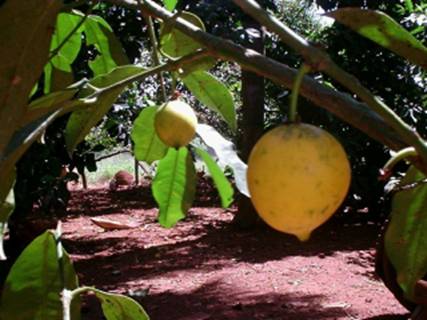GARCINIA GARDNERIANA
COMMON NAMES: BACUPARI, BACOPARÉ
CLUSIACEAE (former Gutiferae)

INDIGENOUS NAME: Bacuparí, comes from the Tupi-Guarani and means “hedgefruit” because of ascending branches that grow horizontally when the plant is in the woods of native forests.
Origin: Amazon Forest, Atlantic Rainforest and reefs in Brazil.
Characteristics: Small tree, 10 to 30 feet (3 to 9 m) tall with simple leaves, coriaceous (stiff texture) and dark green, young leaves are reddish brown and in pairs. The flowers appearing in fascicles (small bundles) on the leaf axils.
Planted at Frutas Raras: September 2000, first flower in 2004 and first fruits in 2005.
Tips for cultivation: Can be grown throughout Brazil, both in full sun or full shade. It adapts to every soil but prefers those that remain wet longer. Resistant to low temperatures down to 25°F (-4°C) and enjoys a lot of soil enriched with organic matter.
Seedling: The seeds lose its ablitiy of germination if not sown immediately after harvest. They germinate in 40 to 90 days. The seedlings grow fast, appreciate more shade to develop. Fruitings starts in the age of 3 to 5 years, depending on soil and crop management.
Planting: Can be planted in either full sun or shade in the forests (so take longer to bear fruit). The holes should be filled with about 50% organic matter and should be made at a spacing of 17 x 17 feet (5 x 5 m). Irrigate with 10 liters of water per week during the first 2 months.
Growing: The bacuparí is not demanding the frequent irrigation, it is one approx. 4 inches (10 cm) thick mulch cover (dry grass) under the crown sufficiently to keep moisture. Fertilize with compost, can be (6 liters) of poultry litter + 50 g of NPK 10-10-10 doubling that amount each year until the 4th year.
Uses: The fruit is sweetish, astringent and refreshing, fit for consumption in-natura. Even the peel can be eaten.
Flower time at Frutas Raras: August to January.
Harvest time at Frutas Raras: November to March.
Back to the seedlist (English) or back to Clusiaceae (Portuguese)